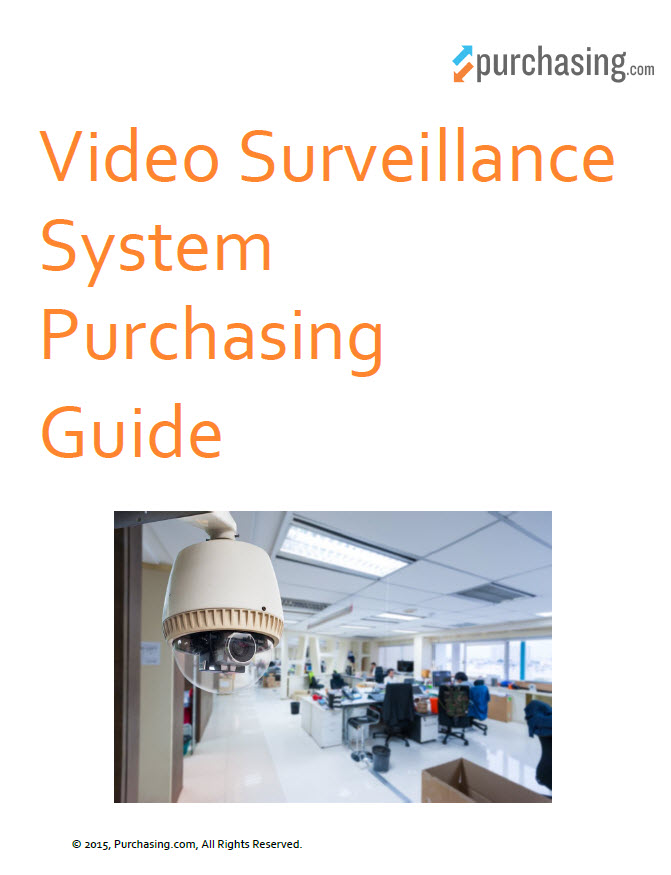Introduction to the Video Surveillance System Buying Process
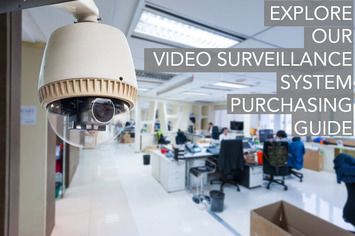 Table of Contents
Table of Contents
- Introduction
- Trends
- Components
- Specs
- Features
- Choosing a Dealer
Introduction
Video surveillance has become the most reliable, cost-effective method of security available. In fact, the mere presence of a video surveillance system has been shown to deter theft, vandalism, and other criminal activity. When a crime does occur, the images captured by the system are often used by law enforcement to recover loss and prosecute suspects - tasks that are far more difficult without the images provided through a video surveillance setup.
Used extensively throughout the world, small businesses like office buildings, convenience stores, restaurants, and retail shops easily deter theft and reduce inventory shrinkage with a basic system in place. Large-scale operations such as industrial complexes, automotive dealerships, schools and college campuses, and military installations are able to secure large areas that would be impossible to staff with a human presence. In this way, inventory is closely monitored and students and employees are protected.
Additional benefits of a video surveillance system include:
- Monitor cash registers, safes, and cash rooms
- Identify employees, guests, and unauthorized individuals
- Observe facilities and working conditions to prevent accidents
- Secure parking lots and building exteriors
- Record day-to-day activity to prevent fraudulent insurance claims
System components
There's a wide range of equipment available, with packages designed to accommodate any budget. But whether you're comparing the top of the line or an entry-level system, most of your purchase decision will be centered on three main components:
- Cameras: Your location and intended use will largely determine what type of camera you buy. There are three main types: overt, covert, and discreet. Overt cameras are plainly visible, capturing images and serving as a deterrent. Covert cameras are concealed in everything from smoke detectors to stereo speakers and record activity without the subject knowing. Discreet cameras are concealed behind a plastic dome, allowing the unobtrusive monitoring of staff and other large areas.
- Monitors: Similar to flat screen TVs, most popular video surveillance monitors are flat-panel LCDs. Size is determined by the number of cameras required (commonly known as input channels). Smaller models are sufficient for one channel; larger monitors are required for the simultaneous display of multiple viewpoints.
- Recording devices: With the development of online SaaS platforms, there are now two options for archiving your video security footage: local hard drives or the cloud. Many surveillance systems still rely on local hard drives but as the cost of cloud-based data backup continues to fall, this is expected to shift in the near future.
Purchase considerations
This guide offers an in-depth look at each of the components mentioned above as well as other factors that will affect your purchase decision. As you read through, answer the following questions:
- How large is the location you'll need to cover?
- How many cameras do you need?
- Will the cameras be installed indoors, outdoors, or both?
- What key areas do you need to monitor?
- Do you require web-based surveillance or remote viewing capabilities?
- How sharp should the camera resolution be? Do you need to identify facial features, license plates, or just basic shapes?
- What type of storage media and backup will be best for you?
- What is your budget?
- Have you planned for additional fees, including setup and installation as well as any monthly maintenance or service fees?
Trends
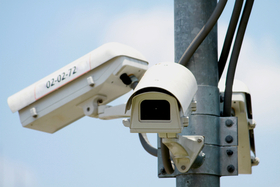 The dealer you select will advise you on important trends that apply to your surveillance needs. But it's a good idea to start with a working knowledge of each to simplify the conversation and ensure you don't over- or under-buy. With that in mind, there are two specific trends to be on the lookout for, which we cover below.
The dealer you select will advise you on important trends that apply to your surveillance needs. But it's a good idea to start with a working knowledge of each to simplify the conversation and ensure you don't over- or under-buy. With that in mind, there are two specific trends to be on the lookout for, which we cover below.
Hardwired vs. wireless connection
There are currently two options when it comes to the wiring of a video surveillance system: hardwired and wireless. The more popular of the two options, hardwired installation, uses coaxial cable to connect surveillance cameras to the system. Security providers continue to prefer coaxial and unshielded twisted pair (UTP) cables due to their reliability, clarity, and ability to reduce the impact of electrical interference between the source and the monitor.
- Purchase comparison: It's worth noting that many wireless devices are only capable of transmissions up to 300 feet (and still require a wired power connection). This dramatically limits their use within a large facility or around an expansive campus. Compare this to hardwired components that can be wired up to 1,500 feet from the monitoring system.
Compatibility is another plus with hardwired systems. Many of the peripheral devices such as cameras, motion sensors, and other integrated security mechanisms can be easily paired with a system upgrade. A common example would be the upgrade of a recording device or the size and resolution of a monitor. Hardwired systems often enable you to use the existing camera setup, as opposed to a wireless system that is dependent upon software that may or may not be compatible with newer components.
But wireless connectivity is not without its benefits. Its plug-n-play functionality makes it extremely easy to install, configure, and expand when surveillance needs change. This feature makes wireless video surveillance ideal for temporary installations, fairs, exhibitions, and other special events. Depending on the size of your location, cost-savings may be another benefit as installation takes place without the CAT5 or similar UTP cable required in a hardwired setup.
Finally, wireless video surveillance is well suited to locations where a hardwired installation would be too costly or physically impossible to install. Examples include applications in and around large bodies of water, rough terrain, and areas with land use restrictions. In areas such as wetlands or those that are home to protected plants or wildlife, wireless surveillance can provide reliable monitoring at relatively low cost.
- Purchasing tip: If your location is largely compatible with a hardwired installation but has a few locations that are inaccessible to wiring, ask your dealer about the possibility of installing a hybrid system. Largely hardwired, it can also be designed to include wireless devices.
IP video surveillance vs. CCTV
CCTV often uses low-end analog cameras to capture a video image. While these cameras may be sold as high-definition (HD), their max resolution is often between 960 x 480 and 704 x 576. This resolution will definitely capture an image up close, clearly depicting a face if the camera is mounted above a cash register for instance. But much of the identifying detail will be lost across distances of a few hundred feet or more. These types of systems may also have trouble capturing detail in objects moving at speed, an automobile for example.
By comparison, many of the cameras now included in a video surveillance system are IP-based. Short for Internet Protocol, these models boast a substantially higher resolution that delivers full frame video at 30 fps (frames per second). Popular models include:
- 1 MP (1280 x 720)
- 2 MP (1920 x 1080)
- 3 MP (2048 x 1536)
- 5 MP (2592 x 1944)
By some estimates, it takes up to six analog CCTV cameras to equal the performance of one 2 MP IP-based model. In addition to cost-savings associated with equipment purchase, the dramatic improvement in quality has led to a widespread transition from classic CCTV setups to IP-based cameras for many businesses. With the growing reliance upon web-based integration, it is likely this trend will continue to develop with each successive generation of equipment.
It's also worth noting that the storage method and monitors used by security personnel have been impacted by this upgraded resolution - both of which are addressed in the next section.
Back to top
Components
The three main components of a video surveillance system (recording devices, cameras, and monitors) offer a wide range of latitude in quality and resulting performance. This allows you to easily build a system that caters to both your security needs and your budget.
But within each category, there are key functionalities and specs to be aware of.
Recording devices
Recording devices - and DVRs in particular - play a pivotal role within video surveillance. They're designed to accommodate an extensive number of channels (or inputs), each originating from a camera that's wired into the system. Many DVRs offer models that increase in cost and scope based on the number of channels they support. Popular configurations include:
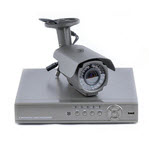
- 4 channels
- 8 channels
- 16 channels
- 24 channels
Though they are referred to as a "digital" video recorder, DVRs are technically an analog device. They capture an analog signal and convert it to a digital format such as MPEG-4. This process actually compresses the image though, reducing the quality.
Popular models are easily configured and typically allow customized definitions for each channel, including settings for video quality and resolution. Though the signal may start out as analog, newer DVRs offer full-HD video output with a resolution of up to 1080p. Video can be exported to a range of different formats, including DVD and USB.
Costs range from $400 to $2,400 (and up) for a single unit depending on the number of channels it supports. Package deals may be able to bring the cost down slightly by including four to eight cameras as well.
Storage
Storage is one of the main considerations when evaluating DVRs. On the low end, a 3-terabyte (TB) hard drive will store about a month's worth of 24-hour video surveillance in full frame HD taken from one camera. This may seem like a lot, but for systems that have 10 cameras or more, you're going to burn through hard disk space pretty quickly. To compensate for this need, popular DVRs accommodate anywhere from 1 to 4 removable SATA hard drives. Each drive offers up to 4 TB.
- Purchasing tip: Figure out how much storage space you need before talking to dealer as it will directly impact the type and size of DVR you'll be comparing. To get a rough estimate, use one of the many storage calculators available on the Internet.
IP cameras and network systems
Digital video recorders (DVRs) are currently the primary means of data storage within many physical video surveillance systems. But with the conversion to digital technology, their upcoming competitor is cloud storage. Though it's considered the cutting edge of video surveillance technology, the cloud-based management and archival of digital video is still somewhat on the perimeter of this sector.
Network video recorders (NVRs) omit the image processor found in a DVR, processing the video images directly through the IP cameras themselves then saving the data to a storage medium. Network systems are the backbone of an in IP-based system and are therefore almost always paired with a VSaaS (video surveillance as a service) solution.
It's worth noting that this type of system is practically limitless in its expandability and architecture. Services, like those provided through Cisco, offer servers that encode up to 64 channels of video and back them up with 12 TB of storage. Video feeds can be viewed on any web-enabled device anywhere in the world. Plus, systems like this are often adaptable to an extensive range of third-party IP cameras, simplifying the upgrade from a physical DVR to a cloud-based system.
With VSaaS, prices range from $2 to $8 per month, per camera. This includes monitoring and data storage. It does not include the cost of the IP cameras, which tend to run between $140 and $2,300 each depending on features (not including installation).
Cameras
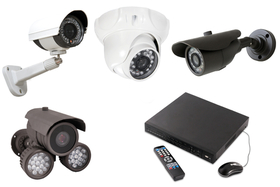 Whether you opt for a standard definition camera on the low end of the scale or an HD IP model, you'll find a number of different cameras available. Each subset is designed for a different application or installation.
Whether you opt for a standard definition camera on the low end of the scale or an HD IP model, you'll find a number of different cameras available. Each subset is designed for a different application or installation.
Some of the most popular include:
- Box cameras
- Dome cameras
- Pan/tilt/zoom (PTZ) cameras
- Bullet cameras
Box cameras
Box cameras get their name from their box-like shape. Often geared toward a CCTV system, they feature interchangeable lenses that enable them to be customized for specific settings. Usable indoors or outdoors, box cameras come with resolutions up to 960H (960 x 480), digital noise reduction, and a 6 to 60 millimeter lens. Equipped with light sensitivity, box cameras can be controlled remotely or set to automatically adjust for high or low lighting conditions.
- Prices average between $130 and $470 per unit.
Dome cameras
Easily spotted in sports venues and around the exterior of buildings, dome cameras are also popular in office environments for their ability to lessen the obtrusive nature of video surveillance. Domes house cameras that offer lenses ranging from 2 to 12 millimeters, provide video in either color or black and white, and are equipped with infrared for low light situations.
Many are weatherproof-rated for exterior installation and manufactured from a high impact plastic and metal body that prevent the dome from cracking. This also protects the camera from damage, tampering, and vandalism. Though there are exceptions, dome cameras are most effective within short distances, including parking lots and building lobbies. Many have a max range of about 90 feet.
- Prices average between $90 and $1,300 per unit.
Pan/tilt/zoom (PTZ) cameras
Available in dome-shaped configurations, PTZ cameras offer a 360-degree panoramic view of any location. Standard video resolution is often 720 x 576 though they go as high as 2 MP. As the name implies, PTZ cameras enable a camera operator to pan (left or right), tilt (up or down), and zero in on a subject with up to a 60x optical zoom. Typically mounted on the ceiling, they are frequently found in venues ranging from churches to ballparks.
- Prices average between $600 and $1,100 per unit for entry level models and $4,000 to $11,300 for the high-resolution cameras.
Bullet cameras
Shaped similar to a telescope or narrow PVC pipe, bullet cameras can be easily and unobtrusively mounted to ceilings or the exterior of structures, providing resolutions of up to 960H (960 x 480). Their slim design gives them two advantages: they can be installed in tight places and are also highly cost-effective. Compared to larger models, bullet cameras provide the same quality as most standard CCTV cameras, offering a lens that ranges from 3 to 16 millimeters. Many also include a secure cable design, housing all wiring within the camera bracket, preventing wear and tear as well as tampering.
- Prices average between $70 and $1,300 per unit.
- Important to note: Camera outputs are measured by the usable image size they create. Most video surveillance models are capable of formats between 1/4-inch and 1-inch. For basic surveillance within small businesses, retail shops, and restaurants, the small formats work just fine. Large campuses, industrial locations, and expansive warehouse operations tend to need a higher resolution. That's why many of them rely on the larger formats like 1/2.5-inch, offering from 1 to 3 MPs and compatible with IP-based systems.
Monitors
 Of the three components, the monitor is probably the least important. This is because the resolution you'll get through most flat screens will be more than adequate for video surveillance. There are two main types: LCD and LED.
Of the three components, the monitor is probably the least important. This is because the resolution you'll get through most flat screens will be more than adequate for video surveillance. There are two main types: LCD and LED.
LCD monitors
LCD monitors are extremely efficient in terms of space and, with the continuing drop in price, have become readily affordable. When comparing monitors, be on the lookout for those that offer resolutions of at least 1366 x 768 with a high contrast ratio (3500:1 is a common example). To avoid "ghosting" (the appearance of a lighter, duplicate image on the screen), compare monitors that offer response times between 5ms and 8ms.
You'll find sizes that range from 17 to 55 inches wide. Remember: the fewer the cameras, the smaller the monitor. As the size of your system increases up to 8, 16, 24, and even 64 cameras, you'll need a larger monitor to provide an adequate size for split-screen viewing of multiple channels.
- Prices average between $350 and $7,890 per unit depending on size.
LED monitors
LED monitors are similar to flat screens in shape and size but feature an additional design element that allows them to be used in bright light and even outdoors. Most include enhanced image production and are built with tempered glass screens that make them slightly more robust than standard LCD monitors. Common configurations include those with resolutions of up to 1280 x 1024, response times of around 5ms, and contrast ratios of around 1000:1.
LED monitors are common among jobsites and other exterior locations as well as commercial environments in which the monitors are frequently cleaned or have to sustain more than the average amount of use and abuse.
- Prices average between $200 and $1,170 per unit depending on size.
- Important to note: When pairing monitors with cameras, make sure the monitor is capable of supporting as close to the resolution of your cameras as possible. Large disparities between the two result in a loss of image quality. You'll save money and receive the highest level of performance when both components are as similar as possible.
Specs
The size and accessibility of your video surveillance system often dictate the type of cameras you'll choose. But there are a few additional considerations that will impact the quality and performance of the system as a whole. These include frame rate, scanning systems, Lux and signal to noise ratio (s/n), which we cover below.
Frame rate
In addition to the resolution of the image itself, video quality is affected by the frame rate, measured in frames per second (fps). This is a representation of the total number of individual images that comprise each second of video footage. According to a recent survey, the average frame rate used by the majority of businesses today is between 6 and 10 fps. But this isn't even close to the max available.
Many HD cameras (with a resolution of 1 MP and above) offer 30 fps to produce "full motion video." This provides a clear video image that remains crisp during zoom operations or while capturing fast moving subjects such as cars or runners. But it's worth noting that a good video image can still be captured with frame rates as low as 15 fps when the camera is focused on a fixed subject.
If you've ever seen choppy-looking surveillance footage, this is the result of a low frame rate - they can actually be set as low as 1 fps to save on disk space. So if fluidity of motion and clarity are important to you, focus on comparing cameras that are capable of higher frames per second.
Scanning systems
Scanning systems often make use of facial recognition software to identify specific individuals. But that's not their sole function. Frequently used in military and harbor patrol applications, most scanning systems are equipped with sensors that enhance color and focal length, easily identifying vehicles, boats, and aircraft. Many units are equipped with a laser pointer to mark subjects as well as an eye-safe laser range finder. Alerts are provided through manual video surveillance monitoring or automatic detection.
In general, there are three types of scanning systems available, broken down by their range of effectiveness:
- Short range - less than 1 mile
- Medium range - 2 to 3 miles
- Long range - 4 to 12 miles
Lux
A camera's sensitivity to light is measured in lux. When evaluating the capabilities of video surveillance cameras, keep in mind the following LUX rating chart:
- Full sun - 10,000 LUX
- Office setting - 500 LUX
- Overcast day - 100 LUX
- Sunset - 10 LUX
- Dawn/dusk - 1 LUX
- Full dark - 0 LUX
You'll notice that the real indicators of camera strength are found at either end of the spectrum. For example, if you're setting up surveillance in areas with continuous sun, you'll want a camera with a lux rating from 7,000 to 10,000. For nighttime surveillance, a rating of 0.5 to 0.1 lux will be most effective.
Signal to noise ratio (s/n)
Signal to noise ratio (s/n) is the difference between actual picture information (referred to as "signal") and distortion or static caused by outside influences (referred to as "noise"). Noise is often the result of neighboring components and is affected most noticeably within a wireless signal. This makes installation an integral part of any good video surveillance system. Check with your dealer on the specific s/n ratio achievable in your location.
As a point of reference, three levels of quality include:
- 60db - Produces an excellent video image with no static visible
- 40db - Video image is acceptable with limited grain or snow visible
- 20 to 30db - Poor picture quality distorted by excessive grain or snow
Lenses
The lens is the final component that impacts the quality of the video image, especially when attempting to capture subjects from a distance or in wide angle. Lenses are designed to pair with a specific camera. An example would be 1/4-inch lenses and 1/4-inch cameras.
Due to the varying needs of each application, lenses are typically sold separate from the cameras themselves. This enables you to easily and cost-effectively tailor the video surveillance system to your specific environment.
When comparing lenses, there are three different options to consider:
- Fixed focal length: By far the most affordable, this type of lens offers a fixed image through a stationary field of view. Designed for large panoramic environments like park-n-rides and freeway traffic monitors, you can expect to pay between $46 and $400 for a this lens with a focal length of 2 to 8 millimeters.
- Variable focal length: This lens allows an operator to adjust the field of view, offering focal lengths from 5 to 120 millimeters. Expect to pay between $40 and $660 depending on the depth of the focal length.
- Motorized zoom: Top of the line, a motorized zoom offers the widest range of control over your video image. Their strength is measure in the number of times the lens can magnify the subject. At the small end of the scale, you'll find zoom lenses with 2x, 4x, and 8x. But for video surveillance purposes, look for lenses that offer 10x to 60x zoom. This is where the price gets a little steep. You can pay anywhere from $700 to $9,800 for lenses in this class.
Features
Added features are the final consideration when it comes to designing the best video surveillance system. Different than image quality or camera specs, video surveillance features are often designed for specialized situations. We cover the most popular features below.
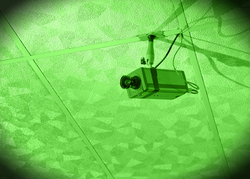 Night vision cameras
Night vision cameras
Offering the same level of connectivity as a standard CCTV or IP-based camera system, night vision cameras operate in a 0 lux lighting environment with IR LED illumination that's effective up to 10 feet. They provide video images for recordings and live video up to 1280 x 800. Many offer varying levels of quality, including low, medium, and high, that allow you to save hard drive space in areas that rarely see nighttime activity.
Fully encrypted, night vision cameras are Wi-Fi and Ethernet ready. Their connectivity allows them to stream real-time video and replay to any web enabled device. Depending on the system you select, cameras may come equipped with night vision features. If not, you can expect to pay $50 to $70 per camera on the low end and up to $600 or more depending on additional features.
Remote viewing capability
Similar to the remote access offered by so many other products and services today, remote viewing allows you to review video surveillance footage on your web-enabled PC or mobile device. This feature essentially turns your tablet, smartphone, or laptop computer into a monitor, eliminating the need for a physical monitor in some cases (mostly smaller systems with only one or two channels).
Most systems that offer remote viewing are compatible with an extensive selection of web browsers, though support is not a guarantee. It is also a standard inclusion with almost every web-based VSaaS that uses IP cameras.
- Purchasing tip: Be careful of the lingo. There is a difference between remote viewing and standard mobile video surveillance - and that difference is control. Remote viewing provides access to the full range of video surveillance controls, including settings, archived video, and the display of multiple live cameras. In contrast, mobile surveillance typically offers a fixed field of view with limited (if any) remote adjustments.
Hidden cameras
Hidden cameras represent an upgrade over standard video surveillance. Designed to fit into light fixtures and switches, smoke detectors, lamps, exit signs, and even clocks, these miniature cameras are meant to catch a subject unaware. But their size limitations do not affect the quality they're capable of.
Hidden cameras offer live and recorded video in resolutions from 176 x 144 to 1280 x 800. They also feature low-light operation, providing excellent quality down to 0 lux. Many include motion detection and a variety of settings that allow you to specify when the camera is activated and the quality of the video once it is. Plus, they're Wi-Fi and Ethernet ready, streaming video images directly to your web-enabled device.
There is one cautionary note here: When installing hidden cameras in a business, you have to be careful not to violate the privacy rights of your employees. For example, a hidden camera installed in a restroom or similar location where people have a reasonable expectation of privacy would violate their rights. Regulations vary from state to state, but most do not require an employer to inform their employees about the use of hidden cameras. In some instances, their placement must be pre-negotiated with appropriate unions.
- Depending on the size and design of the hidden camera, you can expect to pay between $20 and $195.
Black and white / monochrome cameras
One way to save money on a video surveillance system is through the use of black and white cameras. Though they're far from the most popular option, monochrome cameras cost a fraction of their color counterparts. They're somewhat comparable in terms of image quality, delivering up to 704 x 576 and 30 fps on average. Monochrome models also offer day and night functionality, making them ideally suited to retail and convenience stores, malls, and libraries.
- Expect to pay between $200 and $340 for the top of the line and $50 to $68 for basic models. Lenses are sold separately.
Motion detection
This final feature is frequently paired with hidden cameras and night vision cameras. Motion detection actually serves two purposes: (1) it records a subject unaware, typically hidden within a plain looking object, and (2) it saves on memory and hard disc space.
Motion detectors include a built-in sensor that triggers the device when an object passes within a certain proximity. Whether concealed within a light switch or illuminated sign, motion detectors provide a fixed yet wide field of view with angles up to 86 degrees in some cases. Video resolution is around 1280 x 960 and up to 30 fps with night vision capabilities that provide clear images up to 15 feet away. Some models can even take surveillance photos with resolutions of up to 1600 x 1200.
Similar to a hidden camera, cost varies by the quality of the device it's embedded in. Mini desk cams and similar items run from $70 to $200. Attractive clocks and iPod dock stereos with hidden cameras can cost from $190 to $450.
Back to top
Questions to Ask a Dealer
Now that you have a firm grasp on the components that affect the quality and cost-effectiveness of a video surveillance system, it's time to compare dealers. From large installations within expansive industrial properties to small setups in locally-owned small businesses, a professional dealer provides the best mix of consultation, technology, and post-sale support.
Within the industry, dealers are sometimes referred to as integrators. Though the terms are often used interchangeably, video surveillance installers may possess an overall competence related to industry standards and specifications. Integrators hold to the same standards and often specialize in a particular type of expertise that adds value to their services. This can result in cost savings on both equipment and implementation. But regardless of the title, dealers and integrators typically work with a variety of manufacturers and should therefore be able to provide a range of different packages.
There are a number of services - both pre- and post-sale - that can be used to quickly compare dealers. These include:
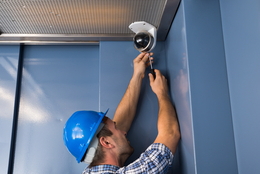 Installation
Installation
Regardless of the scope of a video surveillance system, an effective implementation involves working knowledge of optics, wiring, lighting, security, and any local statues related to personal privacy. The best dealers begin with an analysis of your business to determine the optimal components for the system - customizing it to your exact needs. Before you sign on with a dealer or integrator, find out if they perform their own installations or subcontract to a third-party installer.
Integration with time and attendance software and monitored alarm systems
Don't be put off if a company offers "dealers" rather than "integrators," or vice versa. Both should be able to integrate a video surveillance system with any of your existing systems, from access control to 4G networks. This is especially crucial when integrating with older systems and services that may not support some (or any) of the current features and requirements of digital technology and IP video - your bandwidth representing a primary concern.
Training
Some dealers provide a range of different training options, from web-based audio and video seminars to actual classroom instruction. Those that do provide training resources frequently offer them through the web, enabling you to run through the courses at your leisure.
Give preference to those that offer tutorials on the installation, operation, and maintenance of their products. Training can be a huge plus, both in terms of making a purchase decision and post-sale when training staff. Upfront, training provides a window into the simplicity of the system. Post-sale, it can save you thousands in training costs.
In addition to instruction on their proprietary platform, many dealers stock a wealth of information, from pamphlets and brochures to manuals and DVDs produced by individual manufacturers. This can also supplement your purchase decision or training initiative.
Demonstrations
Another means of pre-sale evaluation, quality dealers typically provide extensive demonstrations, whether conducted at their facility or through a web portal. Using a system of demonstration cameras, you should be able to run through the functionalities of the entire system you're considering, viewing both live and recorded feeds. If you're interested in a specific type of camera or lens, make sure you try one that's at least comparable if not the exact model.
- How does the system stand up to your expectations?
- What would you change if you could?
- How usable is it? Is it complex or straightforward?
Support and maintenance
The breadth and level of support provided by a dealer is another major consideration, especially for large systems with multiple channels that rely on software and system integration. The one benefit of investing in a costlier video surveillance system is that the service package tends to be more affordable than those that typically support basic setups.
Regardless of what you pay, you'll want to ask about:
- Software upgrades: It's not uncommon to find support included for up to five years after purchase
- Hardware support: Dealer should have extensive experience servicing the system you invest in, including all third-party components if applicable
- Mobile integration and support: Free mobile clients are a definite perk
Cost breakdown
In addition to the costs for equipment covered in the Specs and Features sections above, you may opt for a maintenance plan depending on the type of system you invest in. For physical, on-premises video surveillance systems you'll have the option of buying extra coverage under a manufacturer's extended warranty (frequently offered through the dealer too). You can also purchase a maintenance plan that addresses the upkeep of the hardware and any companion software.
Regular cleanings and repairs are necessary. They keep the system up and running, especially when components are exposed to corrosive elements caused by extreme weather, airborne particles, and animals (birds are a prime example).
Expect to pay annual fees around $250 or monthly minimums of about $50. Regardless of the size of your system, most dealers max out their maintenance fees at $5,000 annually.
In addition to maintenance, some components require licensing fees. These are growing in popularity as more and more businesses invest in IP cameras and online VSaaS platforms. Within these setups, the hardware you purchase usually reflects the cost of the license in the price tag - $300 per camera for example. However, some dealers also add a monthly or annual maintenance fee. Give preference to those that negotiate, waive, or bypass this fee altogether, especially with large setups. You're paying enough for the equipment and implementation as it is.
Tips on choosing a dealer
A dealer's background and experience in the industry can provide a clear gauge of their dependability and stability. As your business needs develop, you may want to expand or upgrade your video surveillance system. Working with a dealer who has direct experience in your niche helps your business grow by cutting costs that can be redirected to other business initiatives. If you can't find a dealer that specializes in your exact line of business, consider those that have experience in the size of your operation.
Reviews and references
As you narrow your list of potential dealers, the final step is to gather reviews and references. Start by searching online. Sites like the Better Business Bureau and Yelp can provide a broad picture of a company's strengths and weaknesses.
Get Quotes
- We contact sellers
- They compete for your business
At the same time, ask the dealers you’re most interested in for a list of client references. They’ll give you a sheet with their most satisfied customers. But even these individuals can provide some unique insights into the specifics of that particular dealer.
Ask questions like:
- Has the video surveillance system met your expectations and achieved what you need it to? Has it exceeded these expectations? Has it underperformed in any way?
- What do you think of the image quality for live video? And for recorded video?
- Has the dealer’s initial consultation been helpful to you? Has it affected your bottom line? And if so, how?
- Was the implementation the dealer recommended sufficient? Or did you discover you needed more or less equipment post-installation?
- Have there been any technical issues with the equipment yet? And if so, how quick was the dealer to respond?
- What aspect of service could this dealer improve upon?
Ready to find a dealer? Start here.
